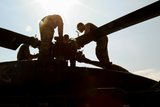How can strong industrial partnerships help to enhance fleet readiness? (Studio)
Brought to you in partnership with Collins Aerospace
Militaries depend on a vast range of systems and equipment, some of which has been in service for decades. Because the future is difficult to predict, sustainment strategies must be adaptable and mobile.
Industrial partnerships play a vital role in developing such strategies. Such arrangements can provide access to the intellectual property and technical data that is vital for effective sustainment, particularly for countries lacking abundant resources.
Collins Aerospace builds relationships across Asia-Pacific with customers with widely varying demands and requirements. Dylan Monaghan is Collins Aerospace’s chief of strategic programmes in the region.
He says the company works with its clients through various routes, including direct sales, US government Foreign Military Sales (FMS), and manufacturing licence agreements, where domestic companies can make Collins Aerospace products under license or in collaboration with the OEM.
‘We can have a collaboration where that part is now developed in our target country, and we’re working with the developer to make it even better for them and fit their needs exactly,’ Monaghan said.
What factors should nations consider in their sustainment strategy? Chris Hill is director of programme strategy for the global sustainment modernisation division in the defence system sector at Northrop Grumman.
He points to several challenges on the aviation side, ranging from obsolescence to diminishing sources of supply, each of which presents a significant threat to military readiness.
‘My sense is that our military customer really wants more flexibility and to be able to make investments in an age of persistent modernisation, where technology is growing faster and more rapidly than the services can adjust their target or aim point.’
Government and industry have a shared interest in close collaboration.
‘Industry is looking for a strong and consistent signal across planning and programming time horizons, to really get the return on their investment on the advancements that they’re making, not only in sustainment, but across an array of capabilities,’ Hill said.
For major aircraft manufacturers such as Bell, sustainability is built into programmes from the beginning, said Mike Moody, the helicopter specialist’s manager, integrated product support – Future Vertical Lift (FVL).
This means that maintainers are included in design elements early in the programme.
For example, when it comes to looking at areas such as component reliability during the design phase, ‘not only is that the purview of engineers, it’s also the purview of maintainers, who have worked in this field their entire lives’.

Ageing military systems face an uncertain future; operators must be prepared for new and often unforeseen responsibilities.
The availability of spare parts is just one crucial factor in ensuring readiness, with broader considerations at play. It’s essential to understand what is driving cost and readiness, and to be able to address those elements in the design process, said Moody.
‘But it’s not only the reliability of those parts, but it’s also the entire system in which they operate,’ said Moody.
‘Once you have designed and built the best part you can produce in industry … you also have to tie that to inspection and maintainability and diagnosis of problems.’
Of course, sustainment needs differ depending on the country or region in question. Asia-Pacific, for instance, presents a massive range of challenges and opportunities.
Hill points to the sheer size and scale of the continent by both population and landmass. He notes ‘the attributes of airpower … speed, range, tempo, adaptability and precision, and what the impacts are of those for military readiness’.
The continent’s vast range of climates ‘also present challenges for sustainment and planning, operations and military execution through the theatre’.
Deanne Barnett is Northrop Grumman’s director of sustainment and modernisation services. She used the example of Australia to outline the advantages offered by industry partnerships.
The approach generally uses performance-based contracts, long-term arrangements with one or two prime contractors, who are themselves supported by a complex, global network of OEMs and technology suppliers.
The governmental defence side too ‘has many organisations involved in the sustainment of the capability, each with different roles, operations, regulations … there’s lots and lots of players in support of a single platform and ensuring sustainment.’

Barnett said Australia has been moving towards a ‘whole of enterprise approach that encourages and ensures all those stakeholders are engaged and aligned in the strategic requirements of the platform and the … issues that need to be managed to make sure it’s successful.’
One mechanism the Australian Department of Defence now uses for its asset management is what is known as the Capability Acquisition and Sustainment Enterprise, or CASE, framework.
The CASE model addresses the increased technological complexity of modern aircraft and allows the Australian DoD to be more inclusive across a broader range of stakeholders.
There is, of course, significant economic variation across nations in this region. Some lack the resources to build economies of scale or cannot secure direct access to American and European capabilities.
Such countries must be selective, prioritising certain aspects of their sustainment strategy.
There is a solid regional trend towards in-country testing and repair capabilities, said Rick Ching, business development manager for Collins Aerospace services and support across Asia-Pacific.
Most operators ‘see this as a benefit, especially for equipment that is critical for their mission – they would like the ability to have it repaired locally and then turn that equipment around very quickly, so as not to incur additional expense’.
Collins Aerospace pursues such arrangements through a range of options. These include its depot partnerships, where it builds collaborative relationships with military service depots to enhance avionics service support.
But no matter the option a customer selects, it will take time to develop and deliver. It is, therefore, wise to plan ahead.
‘It is always good to consider this early on, especially during the lifecycle analysis and planning phase,’ Ching said. ‘They need to put it into a plan and [think about] how they want to go about doing it.’
More from The Critical Care podcast
-
![How has the military placed technology at the heart of aviation sustainment? (Studio)]()
How has the military placed technology at the heart of aviation sustainment? (Studio)
In an increasingly uncertain threat landscape, new and evolving technologies can help sustain ageing aircraft fleets. But to reap the benefits, militaries and industry must collaborate more closely than ever before.
-
![Podcast: Critical Care episode 4 - The operator's view]()
Podcast: Critical Care episode 4 - The operator's view
Welcome to Episode 4 of Shephard Studio’s Critical Care podcast, the story of military aircraft sustainment and support in an unpredictable world.
-
![Podcast: Critical Care episode 3 - Finding the value in military-industry partnerships]()
Podcast: Critical Care episode 3 - Finding the value in military-industry partnerships
Welcome to Episode 3 of Shephard Studio’s Critical Care podcast, the story of military aircraft sustainment and support in an unpredictable world.
-
![OEMs embrace a tailored approach to sustainment (Studio)]()
OEMs embrace a tailored approach to sustainment (Studio)
At a time of rising peer and near-peer threats, enduring force readiness has never been more important for western militaries.
-
![Podcast: Critical Care episode 2 - Delivering a tailored approach to aircraft sustainment]()
Podcast: Critical Care episode 2 - Delivering a tailored approach to aircraft sustainment
Welcome to Episode 2 of Shephard Studio’s Critical Care podcast, the story of military aircraft sustainment and support in an unpredictable world.
-
![Collins Aerospace keeps B-52 bomber flying]()
Collins Aerospace keeps B-52 bomber flying
Collins Aerospace has joined the effort to keep the B-52 Stratofortress in service.
























